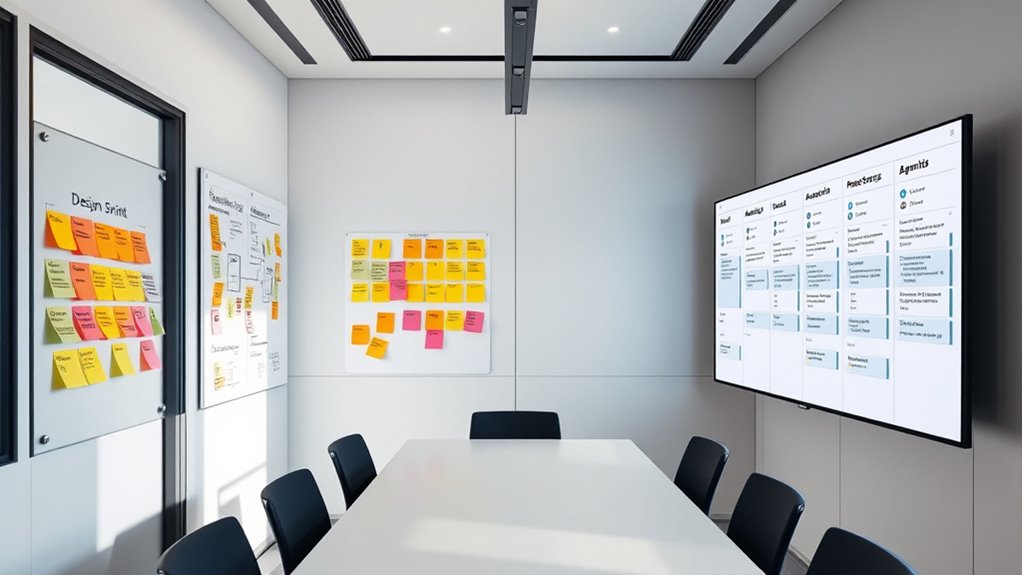Design sprints focus on quickly solving specific problems through a structured five-day process, emphasizing prototypes and user feedback. Agile sprints are shorter, flexible work cycles that support continuous development and refinement over one to four weeks. While design sprints are ideal for rapid validation, agile suits ongoing product improvements. Understanding the differences can help you pick the right approach for your goals, and exploring further will give you clearer guidance for your project.
Key Takeaways
- Design sprints are fixed five-day processes focused on rapid ideation and prototyping, while agile sprints are flexible, lasting one to four weeks with iterative development.
- Design sprints aim to validate ideas quickly and reduce risk, whereas agile emphasizes continuous delivery and ongoing product improvement.
- Design sprints involve small, cross-functional teams with stakeholder input mainly at the start and end, while agile teams include roles like Scrum Master and Product Owner with ongoing stakeholder engagement.
- Choose a design sprint for quick problem-solving and validation; opt for agile when requiring continuous development and refinement.
- Both approaches promote collaboration but differ in structure, duration, focus, and flexibility to suit different project needs.
Origins and Core Objectives of Each Approach
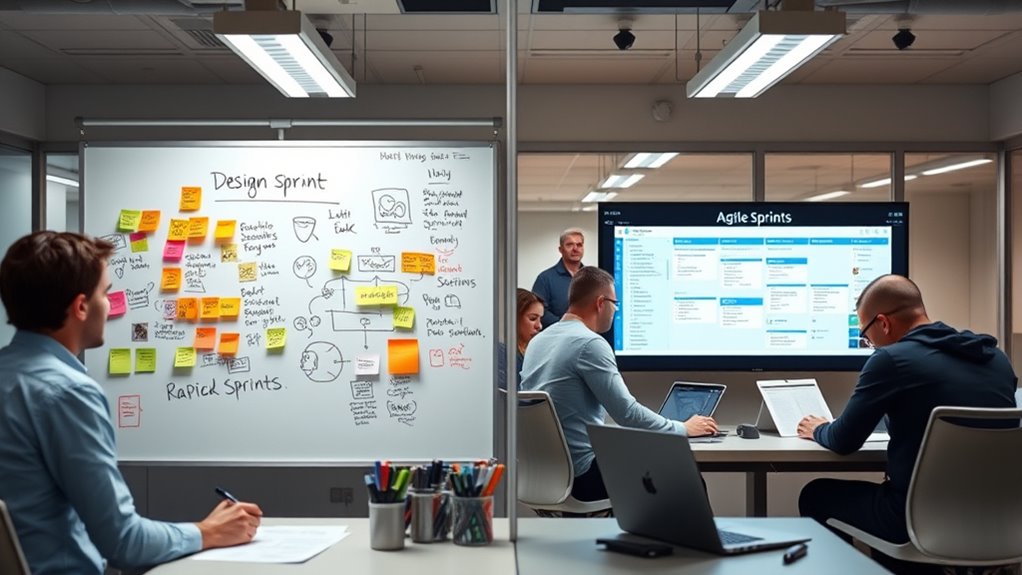
Both design sprints and agile sprints originate from different industry needs, yet they share a common goal of accelerating product development. When you compare iterations, you’ll notice that design sprints focus on rapid problem-solving through a highly structured, five-day process, emphasizing quick ideas and prototypes. Agile sprints, on the other hand, involve shorter, flexible cycles that allow teams to adapt and refine continuously. Stakeholder engagement plays a crucial role in both approaches: design sprints involve stakeholders early for feedback on prototypes, while agile sprints keep them involved throughout ongoing iterations. The core objective of design sprints is to answer critical questions quickly, reducing risk, whereas agile sprints aim for ongoing delivery and improvement, making both methods highly valuable for fast-paced project environments. Additionally, understanding the refresh rates of projectors can significantly influence the effectiveness of visual presentations in fast-paced development environments.
Structure and Duration of Sprints
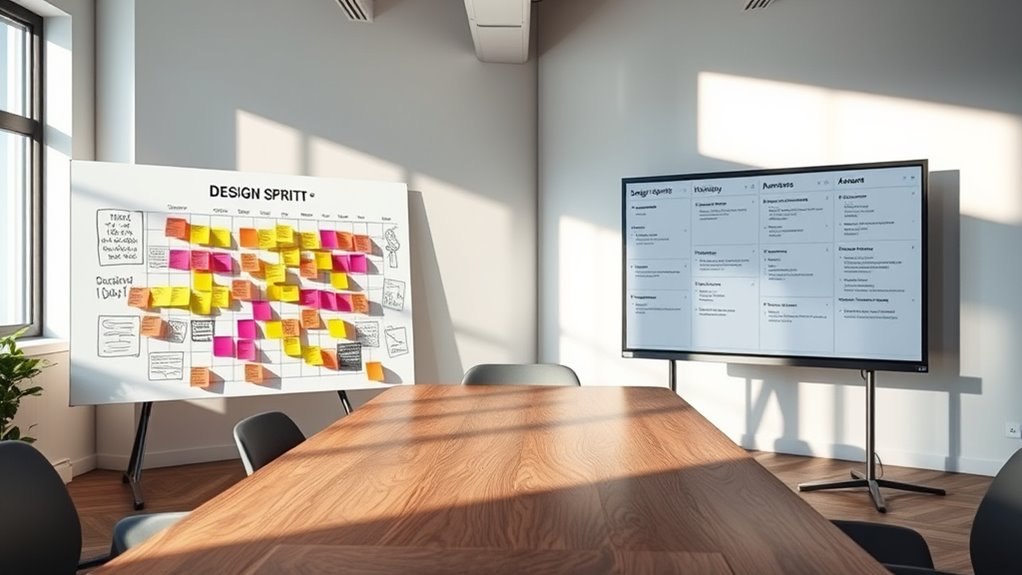
While design sprints are typically confined to a focused five-day timeframe, agile sprints usually span one to four weeks, depending on the project’s needs. During this period, you work through multiple iteration cycles, refining your product incrementally. Sprint planning is essential here, as it sets clear goals for each cycle and helps you manage scope effectively. In agile, each sprint begins with planning, where you determine tasks and priorities, and ends with a review and retrospective to assess progress and identify improvements. This structure allows for flexibility and continuous feedback. Unlike the fixed duration of a design sprint, agile sprints adapt to the project’s complexity, enabling you to deliver value regularly and adjust course as needed throughout the development process. Incorporating clear milestones helps track progress and maintain momentum.
Focus Areas and Outcomes
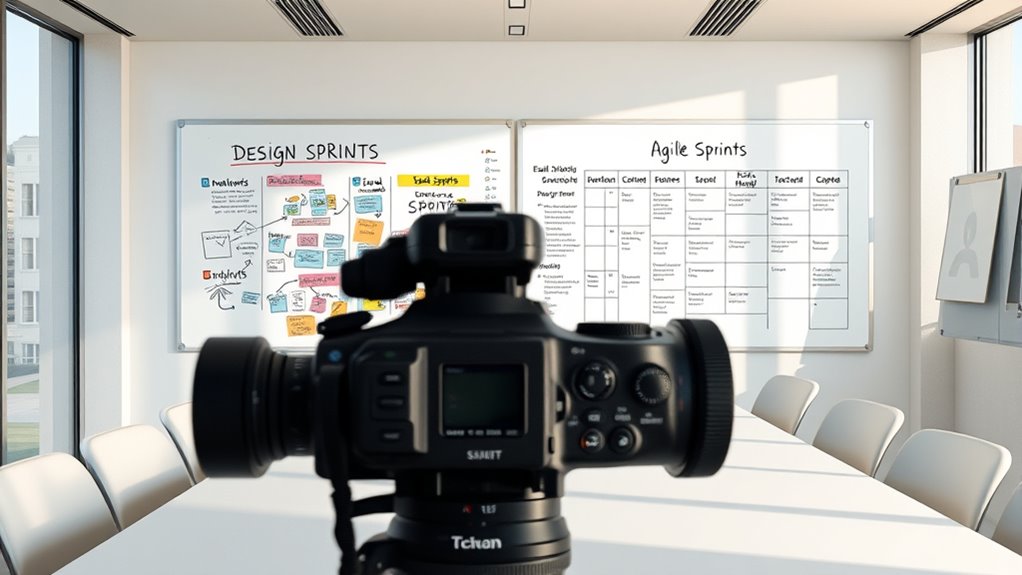
Have you ever wondered how design sprints and agile sprints differ in their focus and expected results? Design sprints concentrate on rapid ideation, prototyping, and gathering user feedback within a short timeframe. They aim to validate ideas quickly before investing heavily in development. In contrast, agile sprints focus on iterative development, delivering small, functional increments that evolve based on user feedback and changing priorities. Industry examples, like tech companies using design sprints to test new features, highlight their emphasis on user-centric innovation. Agile sprints, often seen in software development, emphasize continuous improvement and adaptability. Ultimately, design sprints prioritize problem framing and solution validation, while agile sprints aim for ongoing product enhancement through repeated cycles. Additionally, understanding the different project types can help teams choose the appropriate methodology for their goals.
Team Involvement and Roles
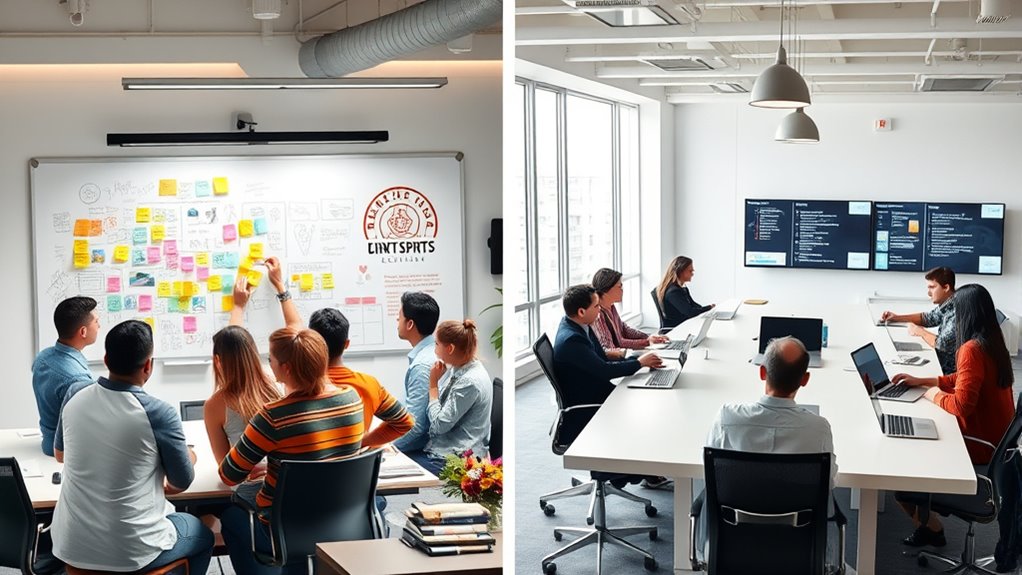
Team involvement and roles differ markedly between design sprints and agile sprints. In a design sprint, you typically work with a small, cross-functional team focused on rapid problem-solving, with stakeholders actively engaged to ensure diverse perspectives. Your team collaborates closely through structured activities that emphasize collaborative decision making, allowing for quick validation of ideas. Agile sprints involve a broader, more ongoing team that regularly collaborates over multiple iterations, with roles like product owner, Scrum Master, and development team members clearly defined. Stakeholder engagement happens continuously, but decision making is more decentralized. Your role is to facilitate communication, ensure everyone understands their responsibilities, and keep the team aligned toward iterative goals. Additionally, understanding team roles and responsibilities ensures effective collaboration and project success. This distinction shapes how each sprint fosters teamwork and project progress.
Choosing the Right Sprint for Your Project

Choosing the right sprint type depends on your project’s goals, scope, and stage. Beyond team structure, consider organizational culture and project type. If your organization values rapid innovation and experimentation, a design sprint can quickly validate ideas without heavy commitments. Conversely, if your project requires ongoing development and flexibility, an agile sprint supports iterative progress. Culture also matters—some organizations prioritize strict processes, favoring agile, while others encourage creative problem-solving, making design sprints more suitable. The project’s nature influences your choice too; a startup focused on rapid prototyping may lean toward design sprints, while a large enterprise with complex workflows benefits from agile’s adaptability. Assess these non-structural factors carefully to select the sprint approach that best aligns with your organizational needs. Additionally, understanding breakfast delivery trends can inspire innovative delivery models for project workflows, emphasizing the importance of adaptability and customer preferences.
Frequently Asked Questions
Can Design Sprints Be Integrated Within Agile Workflows?
You can definitely integrate design sprints within your Agile workflow. This process allows for rapid design and testing, enhancing your Agile adaptation. By scheduling design sprints as focused, time-boxed efforts, you can quickly validate ideas without disrupting your ongoing Agile cycles. This integration streamlines innovation, encourages collaboration, and accelerates product development, making your team more responsive to user needs and market changes.
What Industries Benefit Most From Design Sprints Versus Agile Sprints?
You’ll find that innovation-driven industries like tech, healthcare, and finance benefit most from design sprints because they focus on rapid ideation and user-centric solutions. These industries need quick validation of ideas, making design sprints ideal for fast-paced, industry-specific challenges. Agile sprints work well across broader sectors by enabling continuous improvement, but for breakthrough innovations, design sprints accelerate development and foster creative problem-solving.
Are There Hybrid Models Combining Features of Both Sprints?
Imagine blending a swift, creative brushstroke with a steady, detailed sketch—this is what hybrid approaches do. You can combine features of both sprints, like rapid prototyping from design sprints and iterative development from agile sprints, creating a seamless workflow. With combined methodologies, you gain flexibility and focus, tailoring your process to project needs. This fusion helps you innovate faster while maintaining structure, making your teamwork both dynamic and efficient.
How Do Success Metrics Differ Between the Two Approaches?
When comparing success metrics, you focus on different performance measurements. In Design Sprints, success indicators often include user feedback, prototype effectiveness, and rapid problem-solving. Agile Sprints emphasize ongoing performance measurement through velocity, iteration success, and team collaboration. You should track these metrics to gauge progress, adapt strategies, and make sure your project meets goals efficiently. Recognizing these differences helps you choose the right approach for your specific project needs.
What Challenges Are Common When Implementing Each Sprint Type?
You face challenges like maintaining team alignment and managing resource allocation, whether you’re running a design or an agile sprint. These hurdles can cause confusion, slow progress, or miscommunication. You might struggle to keep everyone on the same page or allocate resources efficiently. Addressing these issues requires clear communication, flexible planning, and strong leadership to keep your team focused and your project moving smoothly forward.
Conclusion
Ultimately, choosing between design sprints and agile sprints is like picking the right tool for your craft. Both aim to accelerate progress—one sparks innovation quickly, the other builds steadily. By understanding their unique beats and knowing your project’s rhythm, you can align your approach perfectly. When you tune into what your team and goals need, you’ll find the rhythm that turns chaos into a symphony of success.
